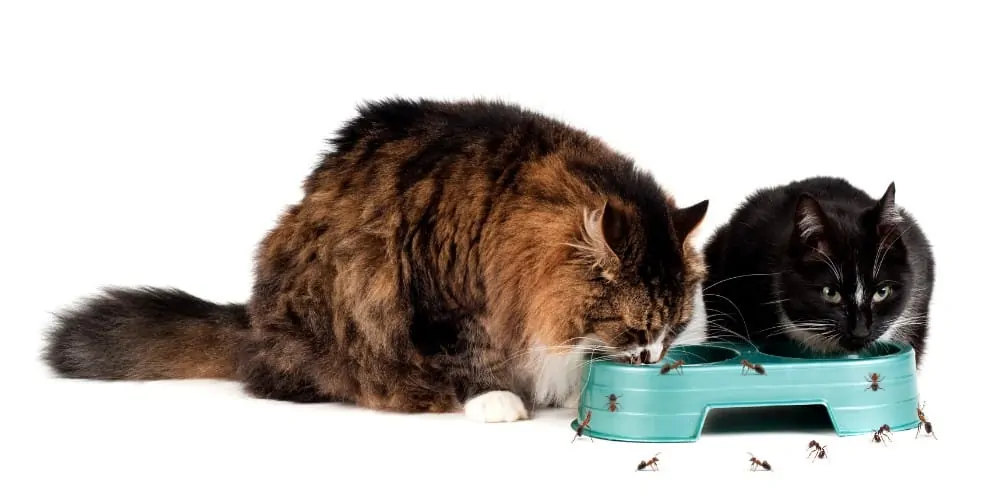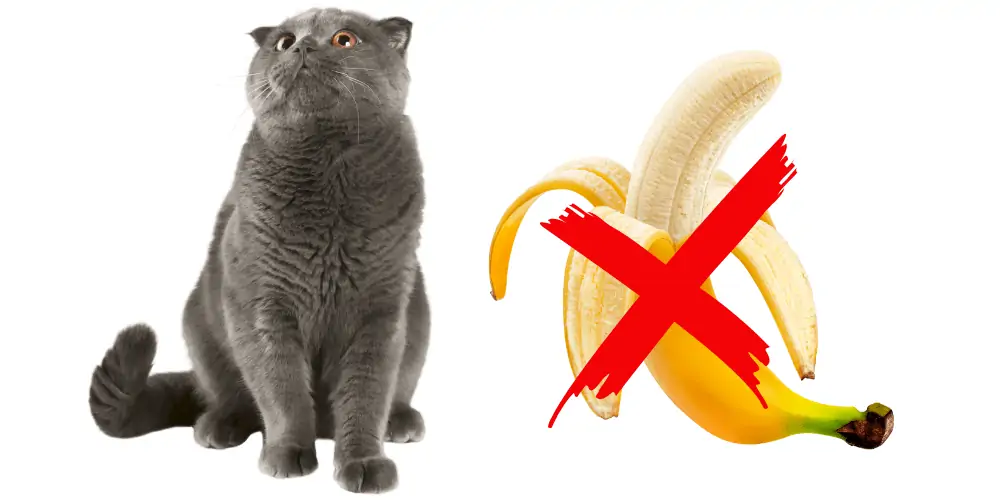Asking questions such as “Can cats eat ants?” doesn’t come out of nowhere.
When people ask about cats or pets in general, they’ve witnessed something happening and get concerned.
This question is one of those situations.
Cats can eat ants except for the fire ant. Cats’ diet involves high amounts of protein, moderate amounts of fat, and a minimal amount of carbohydrates. Ants have 39.79 to 44.64% protein and about 42.07 to 49.77% fat content depending on the body part.
It’s more common to see them pawing around with an ant, but when they eat them, it isn’t only safe but healthy!
Ants also contain chemicals that soften a cat’s coat called alpha-linolenic acid.
Alpha-linolenic acid is an essential fatty acid that is typically found in plants and oils. Cats would normally get this from cat food.
Still, they don’t normally process this particular brand of Omega-3 fatty acid as efficiently as dogs or other animals can.
Vitamins and Minerals from Ants

It doesn’t take a scientist to know that one ant isn’t worth much for anything as it relates to an animal (or person) getting any nutritional value.
However, ants are a good source of protein, zinc, iron, and calcium after eating enough of them.
Also, they are low in calories, fat, and carbs (if anyone’s interested).
Though it sounds strange to those of us in the United States, ants are consumed regularly in many countries around the world and is a major source of protein in these areas.
Can Cats Get Sick from Ants?
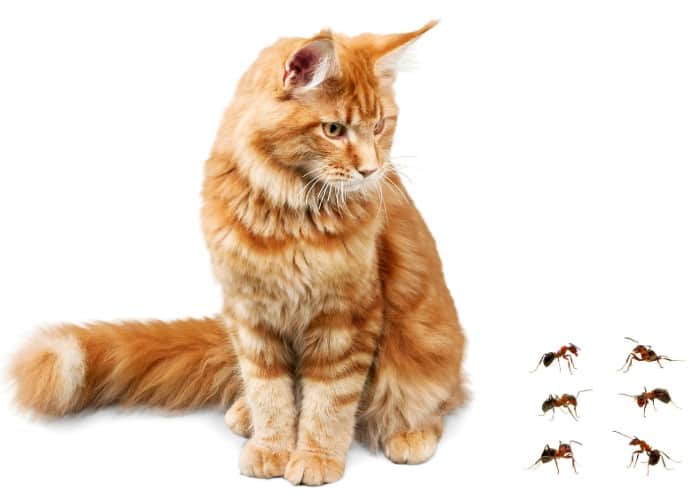
Can cats get sick from eating ants?
Aside from red ants, no. Eating living ants will not bring harm to the cat.
However, if your cat eats ants that have been killed through insecticides, the same poisons that killed them will get into the system of your cat.
To avoid this and save yourself a trip to the vet, always do your best to remove as many killed ants as you can if you’ve used any insecticides.
Red Ants and Your Cat
When Bitten-

Fire ants or red ants often come with a price when a cat tries to toy with them. Red ants respond rapidly and in great numbers when their home is threatened.
In people, their bite can cause burning and swelling and launch some into a dangerous allergic reaction.
The red ant injects a poisonous alkaloid into their victims, resulting in an immediate blistering, stinging sensation.
Though this poisonous bite isn’t typically fatal, it can be life-threatening should one have an allergic reaction.
If such effects happen in adults weighing 150+ pounds, how severe would a bite be on a 6-12lb cat?
It would be harsh, and if the cat isn’t able to flee from a mound in time, the end result could be the death of your pet as the bites accumulate.
When Eaten-
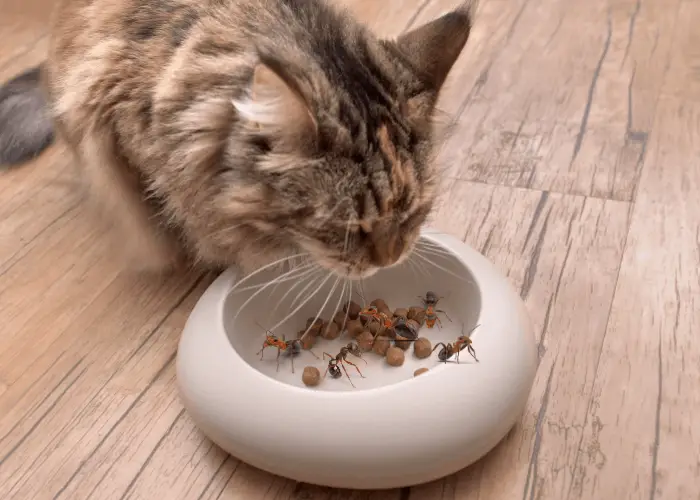
The dangers aren’t so much whether or not eating the red ant is unhealthy for a cat, but there are incredible dangers to the cat if it winds up getting the red ant in its mouth.
If it’s alive, it can still bite. Being bitten somewhere, such as the throat on its way down, can create swelling that closes the cat’s windpipe. Suffocation can come without warning should this occur.
The long and the short of it is, keep your cats away from red ants. If you know of any in your yard, eradicate them immediately, and remove the carcasses.
Do Ants Make Cats High?
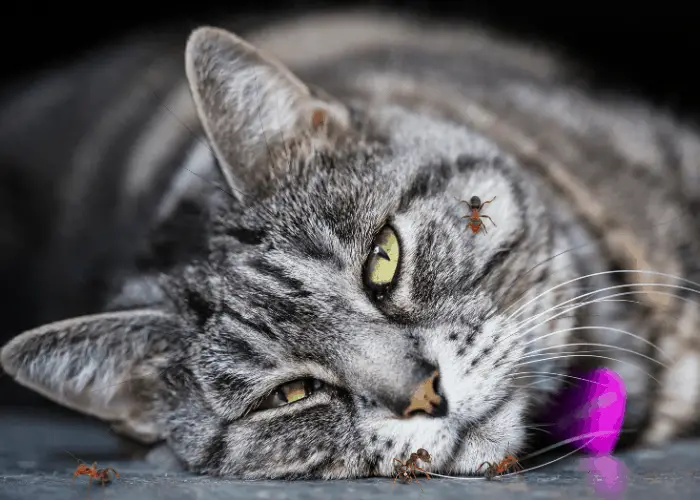
Do ants make cats high?
When squished, stepped on, or what have you, ants excrete oleic and folic acids.
These behave like pheromones for ants, which are picked up by our cat’s sense of smell. This scent creates a calming effect on cats and will cause the cat to spread around some of its own pheromones that emit from its face.
Hence the rubbing around over some recently squished ants.
So, a “high” isn’t the right word for this effect. Rather, a calming influence by way of scent that promotes natural feline behavior.
How Do I Keep Ants Out of My Cat’s Food?

Ants can sure answer the dinner bell when they know a bowl of cat food is waiting for them.
Ants in the food bowl can happen indoors but can get out of control when a cat is fed regularly outdoors.
Some people have more of a problem with this than others, with levels of severity differing by location.
I’ve stumbled across a few horror stories concerning this. One was someone looking for help because red ants would frequently completely encompass the cat’s food bowl- that’s an incredibly dangerous issue, as the previous section says.
But most often, the problem isn’t as severe as that instance. You can do things to satisfy indoor cat food-ant issues as well as outdoor. Here are some tips:
- Store cat food in a plastic container or bin– Ants can crawl into open bags of cat food and munch away but would be hard-pressed to get past a plastic barrier.
- Create an unpassable barrier– Diatomaceous earth (food grade) is a great powder that can kill ants after they attempt to cross it. Food grade DE holds no insecticides or anything else that could harm your cat. Also, if the cat winds up eating a lick of it, it will be fine. DE is even known to be a means to kill flea infestations as well.
- A food bowl island– This is a great solution for the outdoors. Find a tray that is capable of holding a little bit of water, and place the food bowl right in the middle of it. Add water, and there you go. Ants can’t swim and risk drowning if they attempt to reach the bowl. However, it is a good idea to dump the water after the cat is through feeding so as not to create a stagnant water situation. Stagnant water can attract other insects.
- “Cleanliness is right next to antless-ness”– Keeping attractors away, such as food crumbs or residue, will make a big difference indoors and out. Keeping feeding areas clean removes ants’ need to check the area out.
Final Thoughts
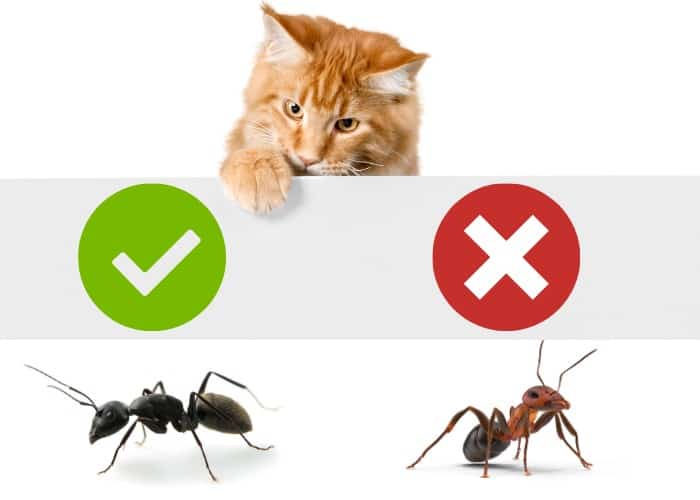
Ants are more of a human nuisance than a cat nuisance. Cats don’t share our prejudices toward insects- even when they should (red ants and bees).
They’ll closely watch ants scurry around, play with them, and eat them. Just another toy catching its attention.
So, if you catch your cat stalking and eating black ants, there’s nothing to worry about. Even if it’s the larger type of black ant that bites- these might bite but do not emit poisons like red ants.
So, to keep your cat safe, take a stroll around the yard and see what kinds of these critters populate the area.
If you notice any red ant hills nearby, remove the problem; other than those pests, it’s all a matter of cats doing cat things and will be fine.
